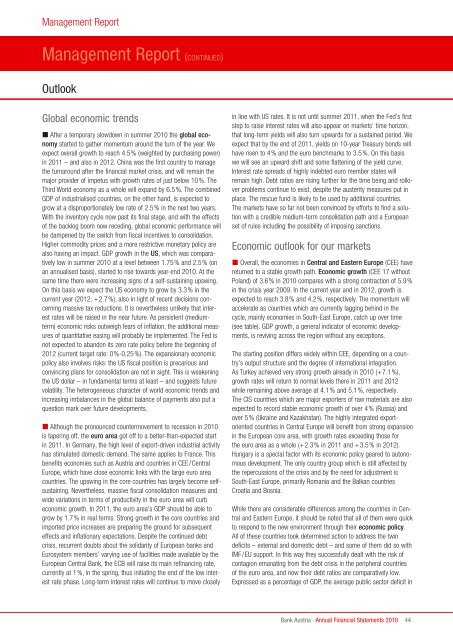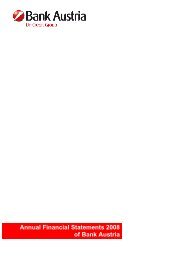Annual Financial Statements 2010 of Bank Austria
Annual Financial Statements 2010 of Bank Austria
Annual Financial Statements 2010 of Bank Austria
Create successful ePaper yourself
Turn your PDF publications into a flip-book with our unique Google optimized e-Paper software.
Management Report<br />
Management Report (CONTINUED)<br />
Outlook<br />
Global economic trends<br />
� After a temporary slowdown in summer <strong>2010</strong> the global economy<br />
started to gather momentum around the turn <strong>of</strong> the year. We<br />
expect overall growth to reach 4.5% (weighted by purchasing power)<br />
in 2011 – and also in 2012. China was the first country to manage<br />
the turnaround after the financial market crisis, and will remain the<br />
major provider <strong>of</strong> impetus with growth rates <strong>of</strong> just below 10%. The<br />
Third World economy as a whole will expand by 6.5%. The combined<br />
GDP <strong>of</strong> industrialised countries, on the other hand, is expected to<br />
grow at a disproportionately low rate <strong>of</strong> 2.5% in the next two years.<br />
With the inventory cycle now past its final stage, and with the effects<br />
<strong>of</strong> the backlog boom now receding, global economic performance will<br />
be dampened by the switch from fiscal incentives to consolidation.<br />
Higher commodity prices and a more restrictive monetary policy are<br />
also having an impact. GDP growth in the US, which was comparatively<br />
low in summer <strong>2010</strong> at a level between 1.75% and 2.5% (on<br />
an annualised basis), started to rise towards year-end <strong>2010</strong>. At the<br />
same time there were increasing signs <strong>of</strong> a self-sustaining upswing.<br />
On this basis we expect the US economy to grow by 3.3% in the<br />
current year (2012: +2.7%), also in light <strong>of</strong> recent decisions concerning<br />
massive tax reductions. It is nevertheless unlikely that interest<br />
rates will be raised in the near future. As persistent (mediumterm)<br />
economic risks outweigh fears <strong>of</strong> inflation, the additional measures<br />
<strong>of</strong> quantitative easing will probably be implemented. The Fed is<br />
not expected to abandon its zero rate policy before the beginning <strong>of</strong><br />
2012 (current target rate: 0%-0.25%). The expansionary economic<br />
policy also involves risks: the US fiscal position is precarious and<br />
convincing plans for consolidation are not in sight. This is weakening<br />
the US dollar – in fundamental terms at least – and suggests future<br />
volatility. The heterogeneous character <strong>of</strong> world economic trends and<br />
increasing imbalances in the global balance <strong>of</strong> payments also put a<br />
question mark over future developments.<br />
� Although the pronounced countermovement to recession in <strong>2010</strong><br />
is tapering <strong>of</strong>f, the euro area got <strong>of</strong>f to a better-than-expected start<br />
in 2011. In Germany, the high level <strong>of</strong> export-driven industrial activity<br />
has stimulated domestic demand. The same applies to France. This<br />
benefits economies such as <strong>Austria</strong> and countries in CEE/Central<br />
Europe, which have close economic links with the large euro area<br />
countries. The upswing in the core countries has largely become selfsustaining.<br />
Nevertheless, massive fiscal consolidation measures and<br />
wide variations in terms <strong>of</strong> productivity in the euro area will curb<br />
economic growth. In 2011, the euro area’s GDP should be able to<br />
grow by 1.7% in real terms. Strong growth in the core countries and<br />
imported price increases are preparing the ground for subsequent<br />
effects and inflationary expectations. Despite the continued debt<br />
crisis, recurrent doubts about the solidarity <strong>of</strong> European banks and<br />
Eurosystem members’ varying use <strong>of</strong> facilities made available by the<br />
European Central <strong>Bank</strong>, the ECB will raise its main refinancing rate,<br />
currently at 1%, in the spring, thus initiating the end <strong>of</strong> the low interest<br />
rate phase. Long-term interest rates will continue to move closely<br />
in line with US rates. It is not until summer 2011, when the Fed’s first<br />
step to raise interest rates will also appear on markets’ time horizon,<br />
that long-term yields will also turn upwards for a sustained period. We<br />
expect that by the end <strong>of</strong> 2011, yields on 10-year Treasury bonds will<br />
have risen to 4% and the euro benchmarks to 3.5%. On this basis<br />
we will see an upward shift and some flattening <strong>of</strong> the yield curve.<br />
Interest rate spreads <strong>of</strong> highly indebted euro member states will<br />
remain high. Debt ratios are rising further for the time being and rollover<br />
problems continue to exist, despite the austerity measures put in<br />
place. The rescue fund is likely to be used by additional countries.<br />
The markets have so far not been convinced by efforts to find a solution<br />
with a credible medium-term consolidation path and a European<br />
set <strong>of</strong> rules including the possibility <strong>of</strong> imposing sanctions.<br />
Economic outlook for our markets<br />
� Overall, the economies in Central and Eastern Europe (CEE) have<br />
returned to a stable growth path. Economic growth (CEE 17 without<br />
Poland) <strong>of</strong> 3.6% in <strong>2010</strong> compares with a strong contraction <strong>of</strong> 5.9%<br />
in the crisis year 2009. In the current year and in 2012, growth is<br />
expected to reach 3.8% and 4.2%, respectively. The momentum will<br />
accelerate as countries which are currently lagging behind in the<br />
cycle, mainly economies in South-East Europe, catch up over time<br />
(see table). GDP growth, a general indicator <strong>of</strong> economic developments,<br />
is reviving across the region without any exceptions.<br />
The starting position differs widely within CEE, depending on a country’s<br />
output structure and the degree <strong>of</strong> international integration.<br />
As Turkey achieved very strong growth already in <strong>2010</strong> (+7.1%),<br />
growth rates will return to normal levels there in 2011 and 2012<br />
while remaining above average at 4.1% and 5.1%, respectively.<br />
The CIS countries which are major exporters <strong>of</strong> raw materials are also<br />
expected to record stable economic growth <strong>of</strong> over 4% (Russia) and<br />
over 5% (Ukraine and Kazakhstan). The highly integrated export-<br />
oriented countries in Central Europe will benefit from strong expansion<br />
in the European core area, with growth rates exceeding those for<br />
the euro area as a whole (+2.3% in 2011 and +3.5% in 2012).<br />
Hungary is a special factor with its economic policy geared to autonomous<br />
development. The only country group which is still affected by<br />
the repercussions <strong>of</strong> the crisis and by the need for adjustment is<br />
South-East Europe, primarily Romania and the Balkan countries<br />
Croatia and Bosnia.<br />
While there are considerable differences among the countries in Central<br />
and Eastern Europe, it should be noted that all <strong>of</strong> them were quick<br />
to respond to the new environment through their economic policy.<br />
All <strong>of</strong> these countries took determined action to address the twin<br />
deficits – external and domestic debt – and some <strong>of</strong> them did so with<br />
IMF/EU support. In this way they successfully dealt with the risk <strong>of</strong><br />
contagion emanating from the debt crisis in the peripheral countries<br />
<strong>of</strong> the euro area, and now their debt ratios are comparatively low.<br />
Expressed as a percentage <strong>of</strong> GDP, the average public sector deficit in<br />
<strong>Bank</strong> <strong>Austria</strong> · <strong>Annual</strong> <strong>Financial</strong> <strong>Statements</strong> <strong>2010</strong><br />
44
















